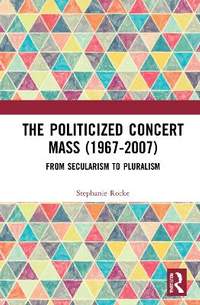
The Politicized Concert Mass (1967-2007): From Secularism to Pluralism
- Author: Rocke, Stephanie
Book
$57.25Out of Stock
Contents
- Introduction
- The concert mass
- Concert mass background
- Conceptual framework and theoretical approaches
- Secularization
- Issues of transcendence
- Religious universalism and pluralism
- Relativism
- Cosmopolitan pluralists
- Book structure and chapter outlines
- Part I: Challenging boundaries in the long 1960s
- Introduction
- Civil protest
- Roman Catholic Activism
- Part I Case Studies – Introducing the masses of Axelrod, Davies and Bernstein
- Chapter 1: David Axelrod and the Electric Prunes’ psychedelic Mass in F Minor (1967)
- Cultural context – the popular music industry
- Mass in F Minor (1967) – The Electric Prunes & David Axelrod (1931–2017)
- David Axelrod – a creative autodidact
- Placing Mass in F Minor within the continuum of other masses
- An absence of religion (secularization)
- Psychedelic Elements of Mass in F Minor
- Text
- Reception
- Psychedelia and the counter culture
- Commodification – Mass in F minor as a product
- Mass in F minor legacy
- Chapter 2: Challenging Christianity: Provocative models in Peter Maxwell Davies’s and Leonard Bernstein’s theatrical concert masses Missa super l’homme armé (1971) and Mass (1971)
- Cultural context – a thirst for change
- Secularization in different spheres
- Missa super l’homme armé (1969 rev. 1971) – Peter Maxwell Davies
- Absurdity
- Sacrifice, betrayal and Christianity
- Mass (1971) – Leonard Bernstein
- Faith
- Social consciousness
- Detractors
- Part II: Expanding the concert mass into new territories
- Introduction
- Subversive protests
- Part II case studies – Chihara and Fanshawe: similarities and differences
- Chapter 3: Christianity as everyday practice: Paul Chihara’s Missa Carminum: Folk Song Mass (1975)
- Background and genesis
- Missa Carminum: Folk Song Mass (1975)
- Text juxtapositions
- Melodic juxtapositions
- Gloria
- Eros in the music of Missa Carminum
- Chapter 4: David Fanshawe’s African Sanctus: A Mass for Love and Peace (1973)
- Cultural and religious merging
- Neo-colonial cosmopolitan patriot
- Cultural and religious hybridity
- Christian and Muslim perspectives
- Transcultural flows
- Conclusion to Part II
- Part III: God meets Gaia: Concert masses for the environment
- Introduction
- Environmental Movement
- New Spiritual Pathways
- Christianity and Environmentalism
- Lindisfarne Association
- Part III case studies – towards natural religion: environmental concert masses of Winter, Patterson, Lentz and Larsen
- Chapter 5: Paul Winter’s Missa Gaia / Earth Mass (1981) and Paul Patterson’s Mass of the Sea (1983)
- Introduction
- Paul Winter’s Missa Gaia / Earth Mass (1981)
- "Earth Fair"
- A concert mass
- Gaia & God?
- Paul Patterson’s Mass of the Sea
- Chapter 6: David Lentz and Jessica Karraker’s wolfMASS (1987) and Libby Larsen’s Missa Gaia: Mass for the Earth (1992)
- Introduction
- wolfMASS (1987) – Daniel Lentz and Jessica Karraker
- Music
- Libretto
- Missa Gaia: Mass for the Earth (1992) – Libby Larsen
- Music for mother Earth
- Libretto – replacement texts and musical choices
- Credo: Speak to the Earth and It Shall Teach Thee
- God?
- Conclusion to Part III – Christianity as religious symbol
- Part IV: Reflecting Religious Diversity
- Introduction
- Historical antecedents
- Concert Masses
- Religious plurality
- Theoretical concepts
- Tolerance
- Moral education
- David Fanshawe – African Sanctus: A Mass For Love And Peace (1973) (Reprise)
- Exclusivism, inclusivism
- Relativism
- Concert Mass responses to plurality – universalism and pluralism
- Chapter 7: Universalistic approaches: Roger Davidson’s Missa Universalis I, II and III (1987–1992) and Luis Bacalov’s Misa Tango (1997)
- Introduction
- Universalism
- Roger Davidson: Missa Universalis I, II and III (1987–1992)
- Nuancing Universalism
- Luis Bacalov’s Misa Tango (1997)
- Tango and Religion
- Lamb of God
- Chapter 8: Towards Pluralism: Carman Moore’s Mass for the 21st Century (1994–1995)
- Introduction
- Abandoning universalism
- Inclusive pluralism
- Carman Moore’s Mass for the 21st Century (1994–1995)
- Universalism and pluralism
- Chapter 9: Pluralism in two twenty-first-century concert masses: Karl Jenkins’s The Armed Man: A Mass for Peace (2000) and And on Earth Peace: A Chanticleer Mass (2007)
- Introduction
- The Armed Man: A Mass for Peace (2000)
- Moving emotions through music
- Choral and commercial success
- Pluralistic aspects
- And on Earth, Peace: A Chanticleer Mass (2007)
- Pluralism and universlism
- Spirituality
- Conclusion to Part IV
- Conclusion: From secularism to pluralism in forty years of politicized concert masses
- Index
- Concert Mass Index



